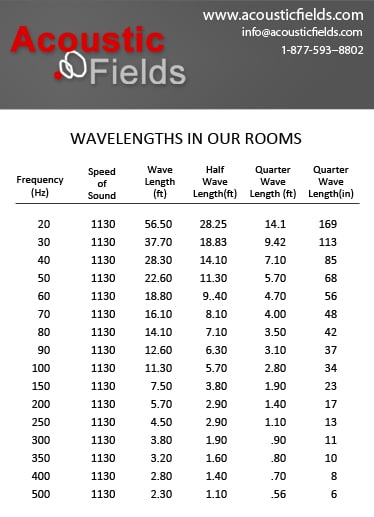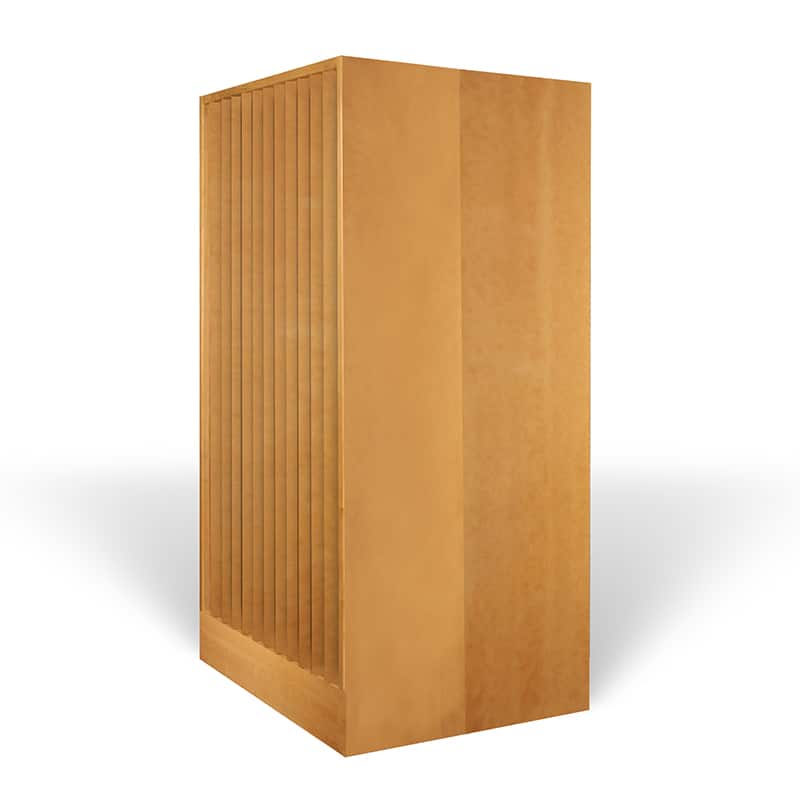Low-Frequency Absorbing Materials
Low-frequency absorbing materials come in many forms. Low-frequency energy is defined as energy below 100 Hz. It is called wave energy because each wavelength or frequency acts like a wave. If you have been in the ocean, you see the waves oscillating from the water to the shore. This is what happens in our rooms. Low-frequency energy from our loudspeakers oscillates through our rooms and fills our room with sound pressure. Middle and high-frequency energy is ray energy and acts like sunshine. It is shorter in length and does not oscillate through the room. Ray energy increases reflections from our wall surfaces. Reflections from our wall surfaces produce high reverberation times which makes speech intelligibility issues difficult.
Wave Energy: https://science.howstuffworks.com/dictionary/physics-terms/frequency-wavelength-light.htm
Low-Frequency Waves
Low-frequency energy is long and tall energy. Low-frequency energy below 100 Hz. can have wavelengths that are 20′ – 40′ long. This is wave energy. Ray energy above 100 Hz. are much shorter. Take a look at the chart below. You will see the full and half wavelengths are shown for each frequency. Understanding the structure of lower frequency energy is critical if you are going to discuss low-frequency absorbing materials. Low-frequency absorbing materials must be able to absorb large amounts of long energy waves. The open-celled foam will not work. Boxes filled with building insulation will not work. How can a box filled with building insulation that is 4″ deep absorb a low-frequency wave that is 38′ long? How can foam that is 2″ thick stop waves of energy that are 38′ long? The answer is that they can not regardless of what the manufacturer states.

Length Of Wavelengths
Helmholtz / Membrane
In acoustics, we have three main types of low-frequency absorbers. We have Helmholtz, membrane, and diaphragmatic absorption technologies. Helmholtz resonators are a cylinder or cabinet with a slot on top of it. The slot depth and length along with the cabinet depth all contribute to the resonant frequency or how low the resonator will absorb at. They are complicated to build and do not absorb a lot of energy. Membrane absorbers are a cabinet with a limp mass membrane stretched over the face of the cabinet. The limp mass acts as a diaphragm and moves in sympathy to the sound pressure placed upon it by low-frequency energy. The membrane thickness and material along with the cabinet depth and density all contribute to the membrane’s absorbers’ frequency of resonance. Frequencies above the resonant frequency are absorbed. Those below are not. Membrane absorbers can absorb over a broader range of frequencies and absorb at a greater amount.
Diaphragmatic Absorbers: https://acousticfields.com/product-category/sound-absorption/acda-series/
Diaphragmatic Absorbers
Diaphragmatic absorbers are the most powerful of all the three low-frequency absorbing materials. A diaphragmatic absorber is a sealed unit that has a diaphragm and a cabinet just like a membrane absorber. The diaphragm has a certain density, the cabinet has a certain depth and density. All of these densities contribute to the cabinet’s resonant frequency which can be designed to go lower than Helmholtz or membrane. They are heavier in weight and can absorb a wide range of frequencies. When looking at low-frequency absorbing materials you can not find a more powerful absorbing technology. With low frequency absorbing materials you need to cover large surface areas with the chosen technology to achieve noticeable results.
Area Coverage
When you are treating frequency issues within small rooms, you must first identify the frequency and amplitude of the low-frequency issues. You must also identify the location of those issues within the room. Every room dimension whether it is width, length, or height has certain low-frequency issues based upon the dimensions of the room and its usage. Once you have identified which wall surface area is causing what frequency and amplitude issue, you must then follow the TAP acronym. You must choose the type of treatment, the amount of treatment, and the position of that treatment. Most treatment types will require that you cover the entire wall surface area in order to achieve enough coverage to have an audible impact on the low-frequency issues.
Low-Frequency Absorbing Materials
There are some natural materials that absorb low-frequency energy. Concrete is an example of low-frequency absorbing materials. Walls within your room can be a low-frequency sound-absorbing technology. It depends on how thick the wall is and how thick the concrete is. It also depends on the construction of the wall and the materials that are used within the walls. The effectiveness of the wall depends on the frequency and amplitude of the issues at that wall locations. Every wall with its length and height has a different frequency and amplitude issue. Couches are often thought to be a low frequency absorbing material. They can be at certain frequencies. The type of material that the couch is made of, how thick the couch is, and where it is positioned within the room must be taken into consideration. A refrigerator can also be a low-frequency absorber. It has depth, a front wall that is rigid, and a cabinet that is dense to seal in cold air.

A “Diaphragmatic absorber” refrigerator
Ideal Room Ratios
The best defense against low- frequency issues within your room is to select the proper room ratios. If you select a balance of width, height, and length that is more conducive to produce less low-frequency energy you are off to a good start. Minimizing low-frequency pressure issues will produce less low-frequency issues that you have to treat. If you have fewer issues to treat, you need fewer treatment types, amounts, and places where you put the treatment technology. Low-frequency energy treatment types require large amounts of space. You must first choose a room size and volume that will minimize the issues produced by low-frequency energy within small rooms. Here is a chart showing some ratios of width, height, and length to consider when choosing a room size and volume to minimize low-frequency issues.
About Us at Acoustic Fields: https://acousticfields.com/about/










I have a small room and most if my mixes are riddled with low frequency. I have cheap monitors but before I purchase new ones I want ti find the most effective way to improve my sound.
A, Fill out the information in this link: https://acousticfields.com/free-room-analysis/
Thanks for the information!
I have an outdoor diesel engine to power an agricultural irrigation pump. Neighbors complain of low frequency noise pollution. Based on your article, it sounds like building a wall around the engine would be best. I was thinking of a chainlink fence lined with a membrane. Does this sound like a viable option for preventing the engine noise? In the article you mention membrane, but do you have any guidance on where I can find such a membrane?
We must first measure the frequency and amplitude of the noise from the engine and then design the appropriate barrier technology.
Hi Dennis problem with low frequency 40/50 Hz coming through conservatory wall fish tank equipment almost touching wall noise all over home council useless. The wall is about 12” inches thick, have applied 2 sheets plaster board sandwich with sound Matt made no difference.or very little please advise Gordon at kayandgordon@icloud.com thank you
With low-frequency noise transmission, you must use a barrier that has multiple material types along with the appropriate densities. You are looking at a wall that is 8 – 10″ deep.
Yes perhaps12 inches of concrete block then plaster boards et cetera do l need another concrete wall with cavity
Thank you
Hello Dennis! Our neighbors put a Ice Bath in their garage which is right below our bedroom and the Low Fregquency noise is driving me mad all night and robbing me of sleep. He won’t move it – is there a solution? Soundproof Carpet and pads? Thank you!
There is no such thing as soundproof anything especially carpet. Low frequency noise transmission requires a permanent construction fix with a barrier that will be 8 – 10″ deep. You must first measure the noise over a time period and then design and build the appropriate barrier technology.